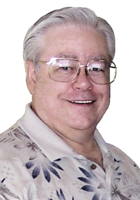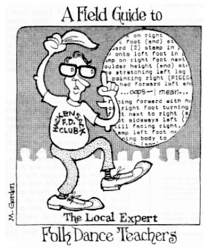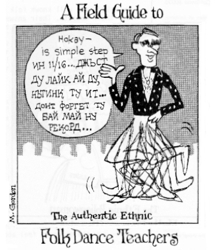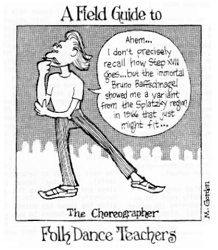
|
The Society of Folk Dance Historians (SFDH)
Teaching Folk Dance
[
Home |
About |
Encyclopedia | CLICK AN IMAGE TO ENLARGE |

|
BACKGROUND
What converts teachers of dance to top-notch dance teachers? For some, the process is evolutionary as they slowly gain experience. For others, the process is the persistent application of studied skills. Let's take a look at some characteristics that are attributed to highly regarded dance instructors.
ON WITH THE SHOW
Teacher attitude is important. Good teachers have an enthusiastic outlook about the material presented, the music used, the students in the class, and themselves. They temper excess enthusiasm by appearing poised and at ease. Good posture and grooming help convey a favorable impression. Controlled tempers and concealment of aches and pains in the best "show must go on" tradition create a positive atmosphere.
GETTING IT TOGETHER
The best teachers are well prepared. They teach only the dances that they know well and have gone over fully in their minds. Some teachers have outlines of all the dances they teach on 3x5" index cards for quick reference.
Knowledge of the music, including the meter and rhythm is a must in the top instructor's bag of tricks. With that knowledge, a dance can be started "in progress" at any part of the music (even after a non-existent introduction). Knowing the name of the dances, with their correct pronunciations, is one hallmark of good teachers. They also know about costumes associated with the dances being taught so they may emphasize any effect those costumes have on the dance style.
Top instructors not only distinguish between the dance styles of different ethnic areas, they also endeavor to learn their dances and styling from the source or from someone as close to the source as possible.
THE TEACHING PROCESS
Although it may seem a small thing at first, one of the most important things the best instructors do is to get all the students moving at the same time. They avoid confusion by saying, "Ready . . . and" to start dancers moving. When they want to demonstrate, they say something like, "Just watch," or "Don't do it yet," (or both!). This allows students to observe a step without the distraction of moving. They verbalize their teaching cues in various ways so all students have an equal chance to learn the dance; for example, with the name of the step motif ("grapevine"), or type of step motif ("hop-step-step"), or other similar cues.
Top instructors progress through complicated patterns at a slowed tempo first and then build to the correct tempo when most of the students can handle it. (A teaching aid in this area is a variable-speed music system.) Regardless of the tempo, they always keep the proper rhythm of the steps.
When teaching students in a circle formation, good teachers usually position themselves with their backs close to one side so their well-projected voices can reach the most students. Then they continuously change their position around the circle so all students have a chance to dance behind them. Of course, they covertly pause longer in front of those students who are having the most trouble. If students are singled out for special attention, it is done without being malicious and with those students who have asked to be corrected before bad habits develop.
Breaking dances into smaller units rather than just demonstrating figures over and over is something else good teachers do well. They know that although the native dancer learns by repetitive association, a lifetime is spent learning a limited repertoire of dances. Top instructors, therefore, build from steps to motifs, to figures, to patterns in logical sequence. And, in perhaps the most important process, they link those units together by actually teaching the transitions from one to another.
Visuals, such as maps, diagrams, and pictures, are also part of the master's stock in trade. While most students want background material about the dances taught, better instrtuctors recognize that the dancing itself is of prime importance and keep speeches to a minimum, usually after some dance movement has occurred. If a dance name is written on a chalkboard, care is taken that all diacritic marks are shown because these determine how the name is pronounced. The country of origin is shown as well as a translation.
Awareness of the students' progress during the teaching tells instructors which portions of the dance need repetition. Repetition can be kept to a minimum, however, by concise teaching that proceeds at a stimulating pace. The good teacher, having used advanced cueing during the instruction, is also aware of when to taper off with the cues so the students begin to do the dance more on their own. Pauses, interjected by asking for questions, allow points to be clarified and time to be budgeted.
AFTER THE DANCE IS OVER
If the dance session is a continuing class (as opposed to a special one-time workshop), the better dance teachers try to review previously taught dances at the following session. If a dance is long or complicated, they often spread the teaching over two or more sessions.
When the teaching is over, dancers appreciate it when the instructor dances with them. Of course, if the instructor is also the programmer, this may be somewhat difficult. On the other hand, most dancers don't appreciate anyone, not even a teacher, who must lead every dance rather than give others a chance to develop their leadership qualities.
Good teachers are secure people who encourage students to attend workshops and camps, even though the students may learn something the teacher doesn't know. These instructors also encourage students to branch out into performing and other enriching areas of ethnic experience.
There are three remaining qualities of good teachers that should be mentioned here. They not only accept criticism good naturedly, but try to correct their admitted mistakes where possible. They try to keep up with popular trends and avoid stagnation by making an effort to never stop learning. Finally, they tend to praise their students when the students do well, even fairly well, rather than criticize when their students do poorly.
In a short article such as this, we can only touch on those qualities we see in the best dance teachers. It may be that few have combined all of the qualities mentioned here in any one session, but the good teachers, if a tally were made, are the ones who would consistently score high!
This article was written for a teacher training seminar that Dick did with Dave Slater in 1982. It also appeared in Folk Dance Scene, Volume 17, Number 9, January 1983 under the title "What Makes a Good Teacher."
DOCUMENTS
- Teacher's Checklist, an article.
- Dick Oakes, an article.
- Source Book for Ethnic and Vintage Dance Teachers, an article.
- Teaching Beginners, an article.
- Teaching of Ethnic Dance, a book.
- Teaching Tips, an article.
Used with permission of the author.
This page © 2018 by Ron Houston.
Please do not copy any part of this page without including this copyright notice.
Please do not copy small portions out of context.
Please do not copy large portions without permission from Ron Houston.



